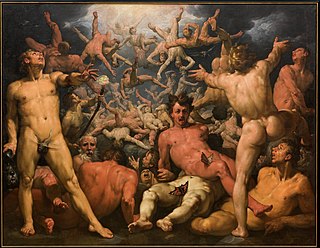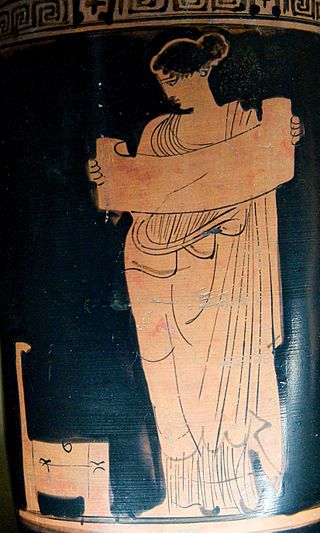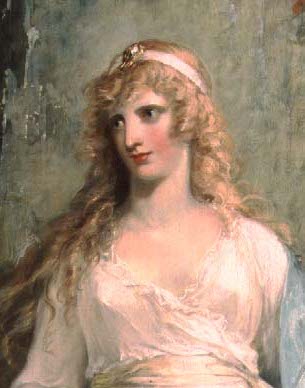
Aeschylus was an ancient Greek tragedian often described as the father of tragedy. Academic knowledge of the genre begins with his work, and understanding of earlier Greek tragedy is largely based on inferences made from reading his surviving plays. According to Aristotle, he expanded the number of characters in the theatre and allowed conflict among them. Formerly, characters interacted only with the chorus.

In Greek mythology, Prometheus is one of the Titans and a god of fire. Prometheus is best known for defying the Olympian gods by stealing fire from them and giving it to humanity in the form of technology, knowledge, and more generally, civilization.

In Greek mythology, Pandora was the first human woman created by Hephaestus on the instructions of Zeus. As Hesiod related it, each god cooperated by giving her unique gifts. Her other name—inscribed against her figure on a white-ground kylix in the British Museum—is Anesidora, "she who sends up gifts".

In Greek mythology, the Titans were the pre-Olympian gods. According to the Theogony of Hesiod, they were the twelve children of the primordial parents Uranus (Sky) and Gaia (Earth), with six male Titans—Oceanus, Coeus, Crius, Hyperion, Iapetus, and Cronus—and six female Titans, called the Titanides or Titanesses—Theia, Rhea, Themis, Mnemosyne, Phoebe, and Tethys. Cronus mated with his older sister Rhea, who then bore the first generation of Olympians: the six siblings Zeus, Hades, Poseidon, Hestia, Demeter, and Hera. Certain descendants of the Titans, such as Prometheus, Atlas, Helios, and Leto, are sometimes also called Titans.

In ancient Greek religion and mythology, the Muses are the inspirational goddesses of literature, science, and the arts. They were considered the source of the knowledge embodied in the poetry, lyric songs, and myths that were related orally for centuries in ancient Greek culture.

In Greek mythology and religion, Themis is the goddess and personification of justice, divine order, law, and custom. She is one of the twelve Titan children of Gaia and Uranus, and the second wife of Zeus. She is associated with oracles and prophecies, including the Oracle of Delphi. Her symbol is the Scales of Justice.

In ancient Greek religion and mythology, Iris is a daughter of the gods Thaumas and Electra, the personification of the rainbow and messenger of the gods, a servant to the Olympians and especially Queen Hera. Iris appears in several stories carrying messages from and to the gods or running errands but has no unique mythology of her own. Similarly, very little to none of a historical cult and worship of Iris is attested in surviving records, with only a few traces surviving from the island of Delos. In ancient art, Iris is depicted as a winged young woman carrying a caduceus, the symbol of the messengers, and a pitcher of water for the gods. Iris was traditionally seen as the consort of Zephyrus, the god of the west wind and one of the four Anemoi, by whom she is the mother of Pothos in some versions.
Tony Harrison is an English poet, translator and playwright. He was born in Beeston, Leeds and he received his education in Classics from Leeds Grammar School and Leeds University. He is one of Britain's foremost verse writers and many of his works have been performed at the Royal National Theatre. He is noted for controversial works such as the poem "V", as well as his versions of dramatic works: from ancient Greek such as the tragedies Oresteia and Lysistrata, from French Molière's The Misanthrope, from Middle English The Mysteries. He is also noted for his outspoken views, particularly those on the Iraq War. In 2015, he was honoured with the David Cohen Prize in recognition for his body of work. In 2016, he was awarded the Premio Feronia in Rome.

Prometheus Bound is an ancient Greek tragedy traditionally attributed to Aeschylus and thought to have been composed sometime between 479 BC and the terminus ante quem of 424 BC. The tragedy is based on the myth of Prometheus, a Titan who defies Zeus, and protects and gives fire to mankind, for which he is subjected to the wrath of Zeus and punished.

In Greek mythology, Calypso was a nymph who lived on the island of Ogygia, where, according to Homer's Odyssey, she detained Odysseus for seven years. She promised Odysseus immortality if he would stay with her, but Odysseus preferred to return home.

Nowa Huta is the easternmost district of Kraków, Poland. With more than 200,000 inhabitants, it is one of the most populous areas of the city. Until 1990, the neighbouring districts were considered expansions of the original Nowa Huta district, and were linked by the same tramway system. They are now separate districts of Kraków.

The Dionysiaca is an ancient Greek epic poem and the principal work of Nonnus. It is an epic in 48 books, the longest surviving poem from Greco-Roman antiquity at 20,426 lines, composed in Homeric dialect and dactylic hexameters, the main subject of which is the life of Dionysus, his expedition to India, and his triumphant return to the west.

In Greek mythology, Pygmalion was a legendary figure of Cyprus. He is most familiar from Ovid's narrative poem Metamorphoses, in which Pygmalion was a sculptor who fell in love with a statue he had carved.
Prometheus is a figure in Greek mythology.

Works and Days is a didactic poem written by ancient Greek poet Hesiod around 700 BC. It is in dactylic hexameter and contains 828 lines. At its center, the Works and Days is a farmer's almanac in which Hesiod instructs his brother Perses in the agricultural arts.

In Greek mythology and ancient religion, Nike is the goddess who personifies victory in any field including art, music, war, and athletics. She is often portrayed in Greek art as "Winged Victory" in the motion of flight; however, she can also appear without wings as "Wingless Victory" when she is being portrayed as an attribute of another deity such as Athena.

Pandora's box is an artifact in Greek mythology connected with the myth of Pandora in Hesiod's c. 700 B.C. poem Works and Days. Hesiod related that curiosity led her to open a container left in the care of her husband, thus releasing curses upon mankind. Later depictions of the story have been varied, with some literary and artistic treatments focusing more on the contents than on Pandora herself.

The Gaze of the Gorgon is a film-poem created in 1992 by English poet and playwright Tony Harrison which examines the politics of conflict in the 20th century using the Gorgon and her petrifying gaze as a metaphor for the actions of the elites during wars and other crises and the muted response and apathy these traumatic events generate among the masses seemingly petrified by modern Gorgons gazing at them from pediments constructed by the elites.
The Trackers of Oxyrhynchus is a 1990 play by English poet and playwright Tony Harrison. It is partially based on Ichneutae, a satyr play by the fifth-century BC Athenian dramatist Sophocles, which was found in fragments at the Egyptian city of Oxyrhynchus.
The Labourers of Herakles is a 1995 play created by English poet and playwright Tony Harrison. It is partially based on remaining fragments of tragedies by ancient Greek dramatist Phrynichos, one of the earliest tragedians. Harrison's play deals with genocide and ethnic cleansing and uses Heracles's filicide as a metaphor for the unspeakable horrors of war and man's inhumanity to man.
















